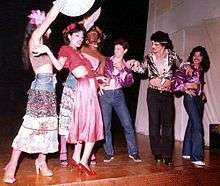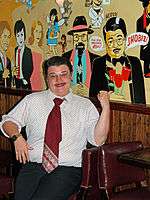Drag king
Drag kings are mostly female performance artists who dress in masculine drag and personify male gender stereotypes as part of an individual or group routine.[1] A typical drag show may incorporate dancing, acting, stand-up comedy, and singing, either live or lip-synching to pre-recorded tracks.[2] Drag kings often perform as exaggeratedly macho male characters,[3] portray marginalized masculinities such as construction workers, rappers, or they will impersonate male celebrities like Elvis Presley, Michael Jackson, and Tim McGraw.[4]
| Cross-dressing |
|---|
|
|
Key elements |
|
Modern drag culture |
|
Sexual aspects
|
|
Other aspects |
|
Passing as male |
|
Passing as female
|
|
Books
|
| Part of a series on |
| LGBT topics |
|---|
| lesbian ∙ gay ∙ bisexual ∙ transgender |
|
Issues
|
|
Academic fields and discourse |
|
|
In the late 1800s and early 1900s, several drag kings became British music hall stars, and British pantomime has preserved the tradition of women performing in male roles. Starting in the mid-1990s, drag kings started to gain some of the fame and attention that drag queens have known.[5][6]
History and terminology


While the term drag king was first cited in print in 1972,[7] there is a longer history of female performers dressing in male attire. In theatre and opera there was a tradition of breeches roles and en travesti.[8] Actress and playwright Susanna Centlivre appeared in breeches roles around 1700.[9] The first popular male impersonator in U.S. theater was Annie Hindle, who started performing in New York in 1867;[10] in 1886 she married her dresser, Annie Ryan.[11] British music hall performer Vesta Tilley was active in the late 19th and early 20th centuries as a male impersonator.[12] Other male impersonators on the British stage were Ella Shields and Hetty King.[13] Blues singer Gladys Bentley performed in male attire in New York, Los Angeles and San Francisco from the 1920s through 1940s.[14] Stormé DeLarverie performed in male drag along with female impersonators at the Jewel Box Revue in the 1950s and 1960s, as documented in the film Storme: The Lady of the Jewel Box;[15] DeLarverie was also a veteran of the Stonewall riots.[16]
The term drag king is sometimes used in a broader sense, to include female-bodied people who dress in traditionally masculine clothing for other reasons. This usage includes women temporarily attempting to pass as men and women who wish to present themselves in a masculine gender role without identifying as a man. Diane Torr began leading Drag King Workshops in 1989 that offer women a lesson in passing as men.[17][18] Torr was featured in the 2002 film on drag kings Venus Boyz.[19]
The first drag king to appear in a television show was New Zealand artist and comedian Hugo Grrrl who won the inaugural season of the New Zealand reality competition House of Drag in 2018.[20]
Drag community

A British lesbian cabaret organization called Lesburlesque made it part of their mission to promote drag kings on the wider British cabaret circuit. Their founder Pixie Truffle gave an interview to the Guardian newspaper in the United Kingdom on her desire for drag kings to close the gap with queens and with male stand-up comedians.[21]
Similar to some drag queens who prefer to be seen as actors—like Justin Bond and Lypsinka—some drag kings prefer not to be pigeon-holed by the drag king label. "I think when people assume that somebody is queer, or different, or trans, they always want to put something before their name," said Murray Hill in an interview. "And that is what drag king has been. Why can not you just call me a comedian like Jerry Seinfeld is called a comedian?"[22]
In recent years, some drag king performers have adopted other terms to describe their own performance styles, particularly if they deviate from the more traditional forms of "kinging". Common names including "gender blurring" acknowledge the merging of both male and female traits in the performances. Vancouver performer Rose Butch adopted the ambiguous label "drag thing".[23] Long-time performer Flare called the stage of drag king styles that emerged in Toronto's scene in the mid-2010s as "unicorn drag".[23]
Drag king names
Names include Christian Adore, Oedipussy Rex, Murray Hill, Slickk Bois and Buck Naked.[24]
Tools of gender illusion
See also
References
- Aronoff, Jen (2005-10-19). "Competitive Drag Kings Strut Stuff: With some spit and polish, women perform in growing world of cross-dressing pageantry". The University of South Carolina Daily Gamecock. Archived from the original on 2007-10-16. Retrieved 2007-07-29.
- Dujour, Dick (2006-08-24). "Drag King Contest". San Francisco Bay Times. Retrieved 2007-07-29.
- Beckner, Chrisanne (2005-09-29). "Best of Sacramento - Drag King: Buck Naked". Sacramento News & Review. Retrieved 2007-07-29.
- Long, Cris (2007-07-22). "Bring Out the Kings!: Gage Gatlyn". Out Impact. Archived from the original on 2007-09-29. Retrieved 2007-07-29.
- "Gage For Yourself". Watermark Online. 2005-09-22. Archived from the original on 2007-08-24. Retrieved 2007-07-29.
- Caceda, Eden (2015-01-13). "Inside Sydney's drag king culture". Hijacked. Retrieved 2015-01-20.
- Oxford English Dictionary cites Rogers, Bruce (1972), The Queen's Vernacular: A Gay Lexicon, Straight Arrow Books
- Senelick, Laurence (2000), The changing room: sex, drag and theatre, Routledge, ISBN 978-0-415-15986-9
- Pix, Mary; Finberg, Melinda (2001), Eighteenth-century women dramatists, Oxford University Press, p. xviii, ISBN 978-0-19-282729-6
- Ferris, Lesley (1993), Crossing the stage: controversies on cross-dressing, Routledge, p. 90, ISBN 978-0-415-06269-5
- Duggan, Lisa (2000), Sapphic slashers: sex, violence, and American modernity, Duke University Press, p. 147, ISBN 978-0-8223-2617-5
- Maitland, Sarah (1986), Vesta Tilley, Virago, ISBN 0-86068-795-3
- Slide, Anthony (1986), Great pretenders: a history of female and male impersonation in the performing arts, Wallace-Homestead Book Co., ISBN 978-0-87069-474-5
- Gladys Bentley articles, Queer Music Heritage, June 2004, retrieved 2009-11-27
- Klotman, Phyllis Rauch; Cutler, Janet K. (1999), Struggles for representation: African American documentary film and video, Indiana University Press, p. 168, ISBN 978-0-253-21347-1
- Rick, Bragg (1994-06-23), "From a Night of Rage, the Seeds of Liberation", New York Times, retrieved 2009-09-12
- Halberstam, Judith (2005), "Drag Kings: Masculinity and Performance (1998)", The Subcultures Reader, Routledge, ISBN 978-0-415-34416-6
- Rapi, Nina; Chowdhry, Maya (1998), Acts of passion: sexuality, gender, and performance, Routledge, p. 237, ISBN 978-0-7890-0370-6
- Kramer, Gary (2006), Independent queer cinema: reviews and interviews, Routledge, p. 165, ISBN 978-1-56023-343-5
- george.fenwick@nzherald.co.nz, George Fenwick George Fenwick is an entertainment writer for The New Zealand Herald (2018-12-20). "House of Drag winner Hugo Grrrl on his 'life-changing' win". NZ Herald. ISSN 1170-0777. Retrieved 2020-03-11.
- "The Guardian Interview with Pixie Truffle about the rise of Drag Kinging". The Guardian. 26 August 2012. Retrieved 26 August 2012.
- Brune, A. M. (2016-03-28). "Murray Hill: 'I'm more than a drag king. Why can't you just call me a comedian?'". The Guardian. ISSN 0261-3077. Retrieved 2020-03-07.
- Friend, David (June 20, 2017). "Kings of the night: New era of gender dynamics offers drag kings a brighter spotlight". CTV News/The Canadian Press. Retrieved June 26, 2017.
- Gregg, Rachel (2006-08-31). "Balls Out". Sacramento News & Review. Retrieved 2007-07-29.
- "Internet Archive Wayback Machine". www.lesbilicious.co.uk.
Further reading
- Halberstam, Judith "Jack"; Volcano, Del LaGrace (1999). The Drag King Book. London: Serpent's Tail. ISBN 978-1852426071.
External links
- Drag king resources
- 'How to be a drag king' by London king Lenna Cumberbatch
- Anderson Toone's drag king time-line with photos and events
- Art of Drag Kinging by Dante DiFranco
- Drag Kingdom, Germany king networking and events site
- Drag Kings at Curlie
- San Francisco Drag King Contest, the oldest (and possibly largest) drag king event
- Technodyke's drag king archived articles and interviews
- Girls will be boys: an article on the otokoyaku, or male role players, of the all-female Japanese Takarazuka Revue
- Radio Documentary, The Drag King Show, produced by JD Doyle for Queer Music Heritage including interviews with Anderson Toone and Leigh Crow.